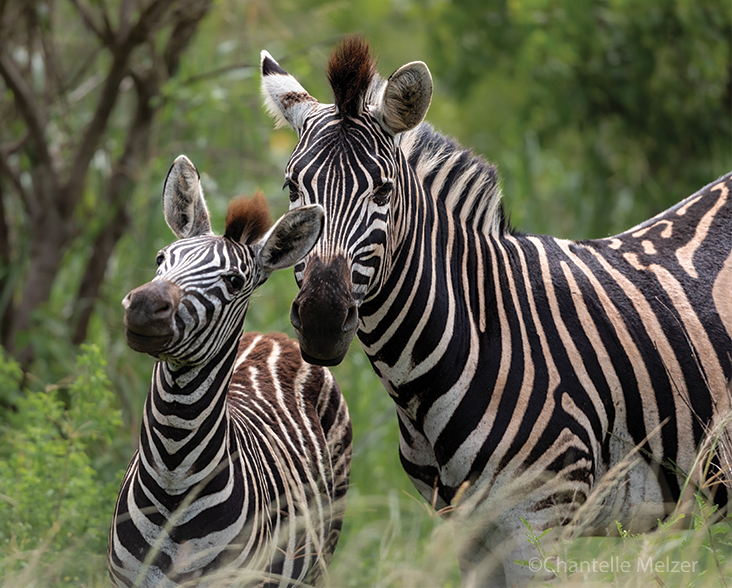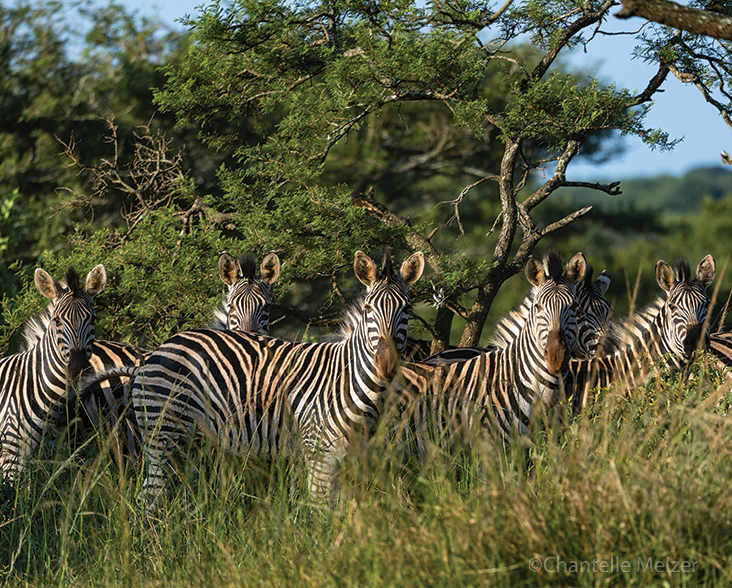Species Data
Class: Mammalia
Order: Perissodactyla
Family: Equidae
Scientific Name: Equus quagga
IUCN Red List status: Near Threatened
Description
This species is 1.3 m in height at the shoulder and between 290-340 kg in weight. Males are slightly larger than females and typically have thicker necks. The Plains Zebra is readily distinguished from the other two zebra species by its distinctive pattern of black and white stripes that are wider in this species and also extend onto the belly. The stripes, some of which may be brown, are vertical and thinner from the head and neck to the forelimbs, becoming broader and more horizontal on the flanks and hindquarters. The facial stripes run vertically from the forehead to the black muzzle and both horizontally and vertically on the sides of the head. The long, erect mane and the 45 cm black-tipped tufted tail are striped, and the short, thin legs are thinly striped horizontally, usually down to the black hooves.
Three of the six or seven subspecies of Plains Zebra also have faint brown ‘shadow stripes’ on the white areas. Each animal’s stripe pattern is unique and can be used to identify individuals. Unlike the Mountain Zebra, the Plains Zebra does not have a gridiron-like pattern of stripes on the rump or a dewlap—a fold of skin under the throat. In the wild, the Plains Zebra can live up to 25 years.
Behaviour
Plains Zebras are diurnal, most active during the cooler temperatures at dawn and dusk and sheltering from the sun or drinking at water holes during the hottest part of the day when they often lay down for 15-30 minutes. Over 50 species of grasses comprise 92% of their diet, with herbaceous dicot forbs, bulbs, roots, leaves, stems, twigs and bark making up the rest.
A social species, Plains Zebras live in tight family groups or harems consisting of a dominant stallion of 8-12 years old, a dominant alpha mare of over eight years old, 2-3 beta mares of 5-8 years old, 2-5 younger mares, and foals and subadults under three years of age. These family groups join to form large temporary herds of sometimes over a thousand individuals. The hierarchy of dominance among mares is established through fighting, with high-ranking mares having priority access to dust baths, shade, water, and other resources. These often brutal fights involve biting and kicking with both the fore and hind hooves and sometimes kill foals. The mare’s rank also determines the hierarchy of the foals.
This species is migratory, and therefore, home ranges are large, varying from 10,000-26,000 ha. Herds move between grazing areas and water sources, often following Blue Wildebeest, covering hundreds of kilometres. Family groups move together in single file, each family group led by the dominant female, with the mares and their foals following in order of rank, and then the dominant male bringing up the rear to defend the group against attack from predators.
Mating occurs throughout the year, although 85% of foals are born during the wet season from October to March. The dominant stallion will mate with up to six mares in the group, and after a gestation period of 12.5 months, mares give birth to a single foal. Mares remain with the group to give birth, with newborn foals strong enough to follow their mother and keep up with the group after just 50-60 minutes. Foals begin to graze at seven days old and wean between 9-14 months. Foal mortality is high, with 60-80% of the foals less than 12 months old predated, and foals that become separated from their mothers are at risk of being kicked to death by more dominant mares. At 2.5 years old, some young mares leave to start new a family group, and young stallions leave the family group at three years old and join bachelor groups.


Habitat
The Plains Zebra inhabits grassland, savannah, shrubland and broken bushveld from sea level to 4,300m on Mount Kenya.
This species occurs across eastern and southern Africa, ranging from South Sudan and southern Ethiopia southwards to South Africa and westwards to southern Angola and Namibia. They are now extinct in Burundi, Lesotho and probably also in Somalia.
Threats and Conservation
The Plains Zebra is considered common and widespread across Africa. The total population is estimated at over 500,000 individuals, including 150,000-250,000 mature animals, however, their exact numbers are unknown due to a lack of survey data and inconsistent methodology applied across their range. Overall, the population is thought to be declining, with numbers decreasing in 10 of the 17 range countries, especially in Kenya and Tanzania. Therefore, the Plains Zebra is categorised on the IUCN Red List as Near Threatened.
This species is threatened by hunting for food and skins across much of its range, especially outside protected areas. One subspecies, the Quagga E. q. quagga of South Africa, became extinct in 1883 due to overhunting and competition with livestock. Other threats include habitat loss due to expanding settlements and agriculture and fencing blocking migration routes.
